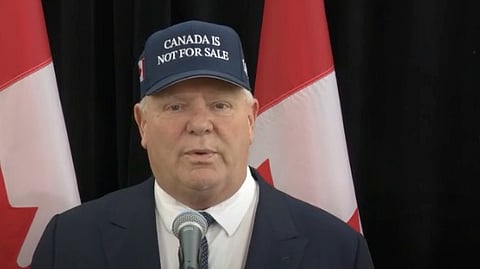

Ontario Premier Doug Ford, the morning after he secured his third consecutive majority government, faced calls for provincial election reform.
The province wasn’t due for an election until the spring of 2026. Yet, Ford on January 28 asked the lieutenant-general for approval to call a winter snap election.
He said at the time he was confident he’d win an even stronger mandate than the majority government he already had to lead the province in a tariff war with President Donald Trump.
So Ontarians headed to the polls on Thursday in record-low voter turnout after a massive snowstorm the week before for an election that yielded a nearly identical outcome to the number of seats that each party already had.
Ford’s PCs were not given a stronger mandate than before. They lost three seats.
The whole process cost taxpayers $189 million.
Ford’s decision for a snap election was an act of self-interest and “a loss for democracy,” Democracy Watch co-founder Duff Conacher told the Western Standard.
The PCs won their third majority “with the support of only 19.5% of eligible voters, which raises serious questions about their mandate to govern, let alone to implement any specific law or policy,” said Democracy Watch in a statement, calling for “democratic changes to Ontario’s political system in response to the clear crisis of low voter turnout in the provincial election.”
Overall, only 45.5% of eligible voters in Ontario cast a ballot, “the second lowest turnout ever,” said the organization, further surmising the seat results were “unrepresentative” of the voting percentages for each party.
Ontario elections in general have a fairly strong voter turnout, with numbers consistently above 50% of eligible voters. The highest voter turnout in modern history was 65% in 1990, and 73% in 1971. Prior to 1971, voter turnout was above 60% or 70%. Going all the way back to 1919 — Ontario saw an 89% voter turnout.
The lowest-ever voter turnout was 43.5% in 2022 when Ford secured his second majority government, according to Elections Ontario. The 2011 election saw 48% voter turnout.
“Only 43% of the ballots cast were for the PC party but they won almost 65% (80) of the seats in the legislature,” said Democracy Watch.
“The Liberals won 30% of the votes but only 11% (14) of the seats, and the Greens won 4.8% of the votes but only 1.6% (2) of the seats. The NDP’s vote percentage of 18.6% was closer to the 22% (27) of seats they won, but still unrepresentative.”
Between the low voter-turnout and a “distorted false majority,” says Conacher, “alarm bells should be going off and questions raised about the legitimacy of Doug Ford’s PC party government which wasted almost $200 million of the public’s money on his self-interested, mid-winter snap election.”
“More and more voters know … they are not going to get what they vote for, and are likely to get dishonest, secretive, unethical, unrepresentative and wasteful government, and as a result no one should be surprised to see voter turnout at such a low level,” says Conacher.
“Voter turnout will go up significantly only if the voting system is changed, if the parties make changes to require everyone in politics to be honest, ethical, open and waste-preventing, and if Elections Ontario does its job properly and informs Ontarians of the real reasons to vote and their right to decline their ballot.”
Democracy Watch outlined six pillars for improving the provincial electoral system, including an honesty-in-politics law, a change in the voting system to better reflect the popular vote, strengthen political ethics and accountability rules, introduce fixed election dates, accurate elections ads and add a “none-of-the-above” category to ballots.
